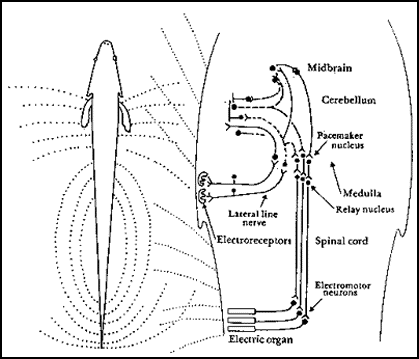
Gold-lined black knifefish, Sternopygus dariensis

Tree of Life: gymnotiformes
Genus sternopygus belongs to order gymnotiforms, one of two orders of weakly electric fish (Zakon, 1987). Weakly electric fish generate an electric organ discharge (EOD) for detecting objects and for social communication (Bass, 1985). The EODs are species specific and are often sexually dimorphic (Zakon, 1993). The frequency and the waveform of the EOD may be altered by sex steroids (Bass, 1985). The relatively uniform, small number of cells of the EOD generating circuitry, accessible for voltage-clamp recording, make the system ideal for the study of the effects of steroids on neural circuits (Zakon, 1993).
The two orders of weakly electric fish are the South American Gymnotiforms and the African Mormyriforms (Zakon, 1987). They are phylogenetically so distant that their EOD systems are thought to have evolved independently (Zakon, 1993). Both groups of fish are further classified as pulse-type or wave-type based on the appearance of their EODs (Bass, 1986). A pulse-type EOD consists of arrhythmic, multiphasic pulses while a wave-type EOD is so called by its sinusoidal shape (Zakon, 1993). When caught prior to or during breeding season or in the breeding condition in the laboratory, the weakly electric fish show sexual dimorphism in their EODs (Zakon, 1987). In general, the duration of the EOD pulse is longer in males than that of juveniles or females in the pulse-type fish (Zakon, 1987). Exogenous testosterone or non-aromatizable androgens broaden the juvenile and female EOD pulse (Zakon, 1993). Estrogen exerts little or no effect on the pulse-type fish (Landsman et al., 1990; Landsman, 1991). In the wave-type fish the EOD frequency of males is typically lower than that of juveniles or females with the exception of the Apterontidae, where the opposite is true (Meyer, 1983; Meyer et al., 1987; Zakon et al., 1991). Estrogen has antagonistic effects to androgens in the wave-type fish (Zakon et al, 1991)
The weakly electric fish detect EODs with their tuberous electroreceptors (Zakon, 1987). The elecroreceptor best frequencies (BFs) are closely tuned to the animals' own EODs and steroid hormones mediate this tuning (Ferrari and Zakon, 1988). It is obvious that the EODs convey information that is necessary for the animals' social interaction. One example of the use of the EOD for communication is 'chirping' behavior of Apteronotus leptorhynchus (Weeks and Levine, 1995). Males of this species transiently increase their EOD frequencies when they sense the EOD of a conspecific (Zakon, 1996). Females rarely chirp naturally; however, androgens masculinize females to develop chirping behavior (Weeks and Levine,1995).

The midline medullary nucleus, called the pacemaker nucleus (PMN) controls the EOD (Bennett et al., 1967). Both mormyriforms and gymnotiforms possess a PMN and their physiological mechanisms are similar (Bennett et al., 1967; Bell et al., 1983). The PMN contains two types of cells, pacemaker neurons and relay neurons (Zakon, 1987). The electrically coupled pacemaker neurons have an endogenous firing rate (Zakon, 1987). The relay neurons send their axons down the spinal cord and form gap junctions with the electromotoneurons (Zakon,1993). The myogenically derived (other than the Apteronotidae, which are neurogenic) electrocytes of the electric organ (Bennett, 1971) are then driven by the innervation by the electromotoneurons (Zakon,1987). Although the frequencies of the EOD are controlled by the pacemaker neurons (Meyer, 1984; Dye, 1991), the wave shape of each pulse is determined by the APs of electrocytes (Mills and Zakon, 1987). In mormyrid and gymnotiform pulse fish androgen induces an increase in the surface area of the electrocyte by enlargement and invagination (Zakon et al., 1992). However, this anatomical change is not observed in Sternopygus, a wave type gymnotiform, thus it is likely the EOD sexual dimorphism is controlled by the alteration of active membrane electrical properties of electrocytes (Zakon et al., 1992) and not by the membrane time constant (Zakon,1993). The Na+ current of Sternopygus electrocytes was shown to have differential inactivation kinetics, and this corresponded with the change in the EOD frequencies (Zakon, 1996). The inactivation was much slower in the fish treated with an androgen than the controls (Zakon,1996). The androgen receptors are found in the electrocytes and they work as a classical steroid receptor, that is, upon binding with a hormone molecule, it is translocated into the nucleus in order to exert its effects on the genome (Gustavson et al.,1994). The input sources of the PMN in gymnotiforms are the prepacemaker nucleus (PPn) and the sublemniscal prepacemaker nucleus (SPPn) (Grant et al., 1986;Kawasaki and Heiligenberg, 1989). Attempts to identify androgen receptors in the PMN neurons have failed (Gustavson et al., 1994), however the androgen receptors are found to be expressed in cells of the PPn and the SPPn in Sternopygus (Zakon, 1996). It is possible that the targets of androgens are the presynaptic neurons of the PMN (Zakon, 1996). The observation that chirps are produced in both sexes of Apteronotus by electrically stimulating the PPn (Zakon,1996) may support this hypothesis.
Image credits: Gold-line black knifefish from Wheeler A, Milne A, Stebbing P (1985)The World Encyclopedia of Fishes. Macdonald Co(Publishers)Ltd; anatomy figure from Bullock T.H. (1973) Seeing the world through a new sense: electroreception in fish.American Scientist,v.61,p.316-325
Hopkins CD(1972)Sex differences in signaling in an electric fish.Science 176:1035-1037.
Hopkins CD(1974)Electric communication in the reproductive behavior of Sternopygus macrurus(Gymnotoidei). Z Tierpsychol 35:518-535.
Bass AH(1985)A hormone-sensitive communication system in an electric fish.Journal of Neurobiology 23:920-932.
Zakon HH(1993)Weakly electric fish as model systems for studying long-term steroid action on neural circuits.Brain Behav.Evol.42:242-251.
Zakon HH(1996)Hormonal modulation of communication signals in electric fish.Developmental Neuroscience 18:115-123.
Dulka JG, Maler L, Ellis W(1995)Androgen-induced changes in electrocommunicatory behavior are correlated with changes in substance p-like immunoreactivity in the brain of the electric fish Apteronotus leptorhynchus.J.Neurosci. 15:1879-1890.
Schaefer JE,Zakon HH(1996)Opposing actions of androgen and estrogen on in vitro firing frequency of neuronal oscillators in the electromotor system.J Neurosci. 16:2860-2868.
